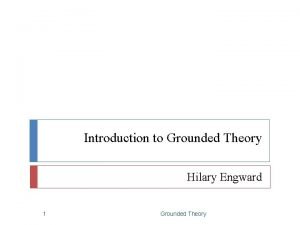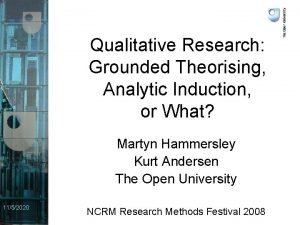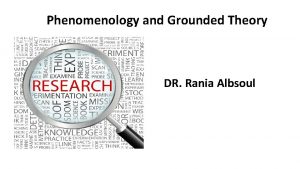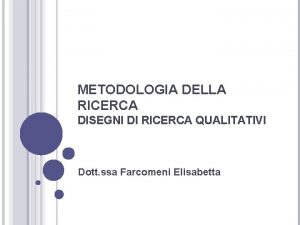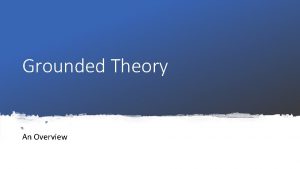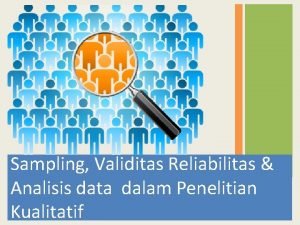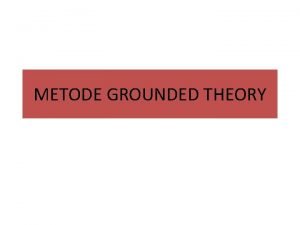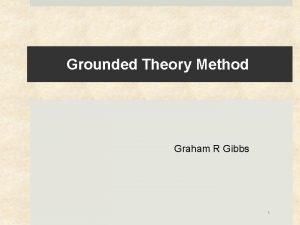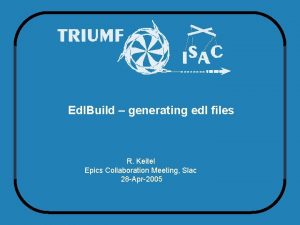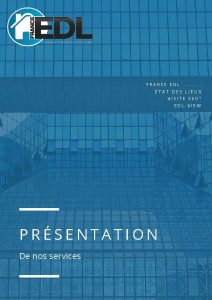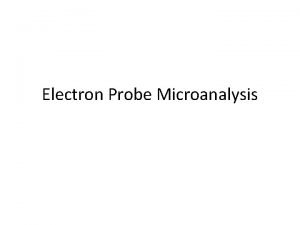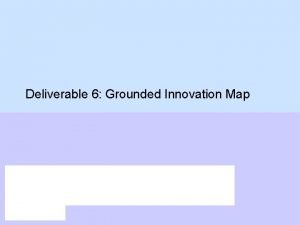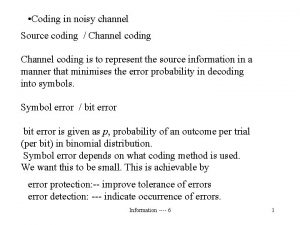Microanalysis Coding Grounded Theory Techniques Part I EDL













- Slides: 13

Microanalysis & Coding: Grounded Theory Techniques Part I EDL 714: 12/1/10

Coding • The analysis of text(s) • Texts can be written, spoken, observed, perceived and represented • Transcripts, notes, and pictures are the most common texts that are coded • There are many approaches to coding • Grounded Theory techniques are one • It is a HIGHLY idiosyncratic process

GT and open coding We are like children seeing a thing for the first time… • Instances – occurrences of that which attracts your attention • Properties – characteristics of a thing • Dimensions – variations of a property along a range • Categories – relate to concepts It is all quite Aristotelian in the end…

Hierarchy of coding strategies • 1 st Order Analysis – Categorical coding – Open coding – Axial coding • 2 nd Order Analysis – Microanalysis – Selective coding – Conceptual analysis – Interaction analysis

Getting started… • In groups of 3 -4, – Discuss your coding of the article “Educating African American Children: Credibility at a Crossroads” – What was your approach? – What were your results? – What questions do you have about the process?

Microanalysis & basic operations • Asking questions • Types of questions (p. 72) – Sensitizing – Theoretical – Practical and structural – Guiding • Making theoretical comparisons • Insight: Is it data?

Exercise: Microanalysis of data • Example 1: Excerpt from a field interview with a high school principal • Example 2: Excerpt from a field observation of a mathematics classroom • In groups of 2 -3 microanalyze the excerpts using the methods modeled by Corbin & Strauss (see Ch. 4 for more analytic tools)

Upon reflection… • What types of questions did you ask? • Did the data speak to you? • Did the nature of the data influence your microanalysis? • If you had more of this data to examine, what would you do next?

An essential question… “From a qualitative perspective, what are the key considerations in studying the data of activity versus self-reported data? ”

Exercise in open coding • Use your interview(s) from last summer • Select a meaty, but not too lengthy excerpt (if you do multiple transcripts, pick responses to the same question) • Conduct a microanalysis of the excerpt(s)

Upon reflection… • What did you see? • Why do you think you saw this? • Did your earlier microanalysis of part of this interview influence your further coding?

A word of warning… • Beware developing a false sense of precision • Qualitative hubris • Never take a conclusion for granted • This goes to the heart of how we view validity in qualitative analysis (see next week’s readings)

Protocols & instrumentation • Setting the stage for open coding • Instruments should anticipate and support the analytical process • Questions should be consistent with an “open” analytical approach • Instruments should allow for emergent findings • These tools are keys tools in bringing/imposing order on data
 Grounded theory coding
Grounded theory coding Grounded theory
Grounded theory Contoh open coding, axial coding selective coding
Contoh open coding, axial coding selective coding Open coding adalah
Open coding adalah What is grounded theory in simple terms
What is grounded theory in simple terms Analytic induction vs grounded theory
Analytic induction vs grounded theory What is grounded theory in simple terms
What is grounded theory in simple terms Ricerca qualitativa infermieristica
Ricerca qualitativa infermieristica Axial coding
Axial coding Ethnography qualitative research
Ethnography qualitative research Conditional matrix grounded theory
Conditional matrix grounded theory What is holistic perspective in qualitative research
What is holistic perspective in qualitative research Kathy charmaz
Kathy charmaz Validitas data kualitatif
Validitas data kualitatif

